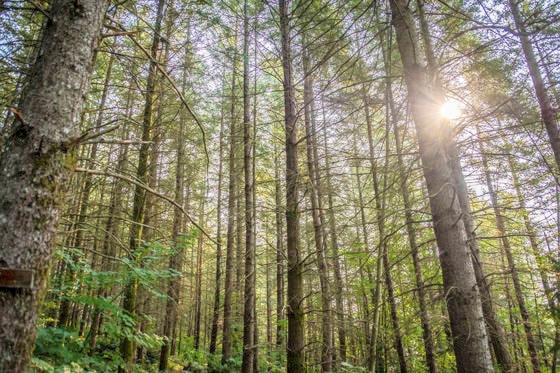Changes in logging practices could help B.C. meet its ambitious goal of reducing carbon emissions, suggests a paper written by two Terrace-based foresters.
Although forests are regarded as key to storing carbon, logging releases that carbon, something Rick Brouwer and Brittany Dewar say could be reduced by regulations and policies outlining which trees should be cut and when, which trees should be left, how roads are built to logging sites and how waste wood is treated.
While cautious about the paper’s conclusions, and stressing that more work is needed to determine the level of carbon emission reduction that’s possible, the pair are optimistic.
“The question is can we have a long term impact,” said Brouwer. “If we don’t start at least, we won’t get there.”
Commissioned by the Forest Enhancement Society of B.C., a provincial agency which helps finance projects to improve the use of the province’s forest resource, the study examined nine areas in which policy and regulation changes would have an influence.
The idea for the study grew out of contact with an employee of B.C.’s forestry ministry regarding better utilization of waste material that traditionally had been left to be burned, an action that contributes to carbon release.
“From there it broadened to what we could do with policy changes — you should always do things to reduce your footprint. But can you do this economically,” said Brouwer.
One area the pair zeroed in on was road building which, by its nature of clearing trees and disturbing the ground, releases carbon. Narrower and shorter roads or building roads on snow during the winter would reduce emissions.
Bringing about the above would require a policy shift in that forestry companies can now deduct the cost of road-building from the stumpage fees the province charges for the wood that’s cut.
“But if you build less road, logging would cost more if your stumpage goes up. And that’s why you would need a policy change to make it more practical,” Brouwer noted.
In that sense, carbon would then be treated as a commodity and one which would then have a value to the forest industry.
The pair also advocate for increasing the stumpage rate charged for waste that’s left in the forest where, as it rots or burned, carbon would be emitted.
This would encourage companies to instead make the waste available to facilities which can turn the waste into biomass such as pellets. But that would only work if there are facilities nearby.
Letting trees grow longer before they are cut would also increase their value in storing carbon, said Brouwer.
“I can see that in selection harvesting — allowing the trees to do their thing,” he said, adding they would still have a value when eventually logged.
Using what Brouwer admits are rough calculations, if their proposals are applied to 10 per cent of the province’s annual harvest area, carbon benefits could amount to more than 10 million tonnes of carbon equivalent by 2030 and more than 30 million tonnes by 2050.
That’s not an insignificant amount given the province’s annual greenhouse gas emissions in 2017 amounted to 64.5 million tonnes and it’s why he’s calling for verification of the study.
Brouwer is suggesting the northwest be the location for pilot projects to test the study’s findings although cautioning that what might be applicable here may not be in other parts of the province.
“But I do think there’s a benefit. If we know we can have a carbon benefit, we can move forward,” he says.
The study caught the attention of the committee set up to monitor the Kalum Land and Resource Management Plan, a 2001 document that sets out strategies and objectives on resource use in the Terrace and Kitimat area of the northwest.
“I am very encouraged to see this detailed level of investigation on carbon management applicable to forest operations in the northwest BC,” said committee co-chair Norm Parry following a presentation made by Brouwer earlier this year.
”I look forward to seeing how this report is used and showing us how the industry is contributing to climate change mitigation measures. We will be following up on the process and outcomes.”
Gord Pratt from the Forest Enhancement Society of B.C., which financed the report, described the report as a valuable document for advancing the goal of reducing carbon emissions.
“It suggests changes on how we can do things in the bush,” said Pratt. “How we can all do our bit.”
The report is now circulating within in the policy arm of the forests, lands, natural resource operations and northern development ministry.
While too early to indicate what changes might result from the report, Pratt said that anything an industry can do to reduce carbon emissions is worth considering.
“There are already changes underway — improving our utilization for less burning,” he noted.
Ultimately, said Pratt, the challenge is incorporating how logging is done while still maintaining the strength and economic viability of the forest sector.
